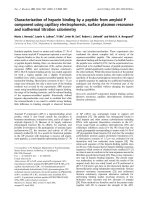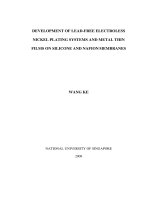The deposition of Zn doped SnO2 thin films by a compression sprayer for alcohol vapor sensor
Bạn đang xem bản rút gọn của tài liệu. Xem và tải ngay bản đầy đủ của tài liệu tại đây (690.39 KB, 8 trang )
������������������������������������������������������������������������������������������������������������������������������������������������������������������������������������������������������������������������������������������������������������������������������������������������������������������������������������������������������������������������������������������������������������������������������������������������������������������������������������������������������������������������������������������������������������������������������������������������������������������������������������������������������������������������������������������������������������������������������������������������������������������������������������������������������������������������������������������������������������������������������������������������������������������������������������������������������������������������������������������������������������������������������������������������������������������������������������������������������������������������������������������������������������������������������������������������������������������������������������������������������������������������������������������������������������������������������������������������������������������������������������������������������������������������������������������������������������������������������������������������������������������������������������������������������������������������������������������������������������������������������������������������������������������������������������������������������������������������������������������������������������������������������������������������������������������������������������������������������������������������������������������������������������������������������������������������������������������������������������������������������������������������������������������������������������������������������������������������������������������������������������������������������������������������������������������������������������������������������������������������������������������������������������������������������������������������������������������������������������������������������������������������������������������������������������������������������������������������������������������������������������������������������������������������������������������������������������������������������������������������������������������������������������������������������������������������������������������������������������������������������������������������������������������������������������������������������������������������������������������������������������������������������������������������������������������������������������������������������������������������������������������������������������������������������������������������������������������������������������������������������������������������������������������������������������������������������������������������������������������������������������������������������������������������������������������������������������������������������������������������������������������������������������������������������������������������������������������������������������������������������������������������������������������������������������������������������������������������������������������������������������������������������������������������������������������������������������������������������������������������������������������������������������������������������������������������������������������������������������������������������������������������������������������������������������������������������������������������������������������������������������������������������������������������������������������������������������������������������������������������������������������������������������������������������������������������������������������������������������������������������������������������������������������������������������������������������������������������������������������������������������������������������������������������������������������������������������������������������������������������������������������������������������������������������������������������������������������������������������������������������������������������������������������������������������������������������������������������������������������������������������������������������������������������������������������������������������������������������������������������������������������������������������������������������������������������������������������������������������������������������������������������������������������������������������������������������������������������������������������������������������������������������������������������������������������������������������������������������������������������������������������������������������������������������������������������������������������������������������������������������������������������������������������������������������������������������������������������������������������������������������������������������������������������������������������������������������������������������������������������������������������������������������������������������������������������������������������������������������������������������������������������������������������������������������������������������������������������������������������������������������������������������������������������������������������������������������������������������������������������������������������������������������������������������������������������������������������������������������������������������������������������������������������������������������������������������������������������������������������������������������������������������������������������������������������������������������������������������������������������������������������������������������������������������������������������������������������������������������������������������������������������������������������������������������������������������������������������������������������������������������������������������������������������������������������������������������������������������������������������������������������������������������������������������������������������������������������������������������������������������������������������������������������������������������������������������������������������������������������������������������������������������������������������������������������������������������������������������������������������������������������������������������������������������������������������������������������������������������������������������������������������������������������������������������������������������������������������������������������������������������������������������������������������������������������������������������������������������������������������������������������������������������������������������������������������������������������������������������������������������������������������������������������������������������������������������������������������������������������������������������������������������������������������������������������������������������������������������������������������������������������������������������������������������������������������������������������������������������������������������������������������������������������������������������������������������������������������������������������������������������������������������������������������������������������������������������������������������������������������������������������������������������������������������������������������������������������������������������������������������������������������������������������������������������������������������������������������������������������������������������������������������������������������������������������������������������������������������������������������������������������������������������������������������������������������������������������������������������������������������������������������������������������������������������������������������������������������������������������������������������������������������������������������������������������������������������������������������������������������������������������������������������������������������������������������������������������������������������������������������������������������������������������������������������������������������������������������������������������������������������������������������������������������������������������������������������������������������������������������������������������������������������������������������������������������������������������������������������������������������������������������������������������������������������������������������������������������������������������������������������������������������������������������������������������������������������������������������������������������������������������������������������������������������������������������������������������������������������������������������������������������������������������������������������������������������������������������������������������������������������������������������������������������������������������������������������������������������������������������������������������������������������������������������������������������������������������������������������������������������������������������������������������������������������������������������������������������������������������������������������������������������������������������������������������������������������������������������������������������������������������������������������������������������������������������������������������������������������������������������������������������������������������������������������������������������������������������������������������������������������������������������������������������������������������������������������������������������������������������������������������������������������������������������������������������������������������������������������������������������������������������������������������������������������������������������������������������������������������������������������������������������������������������������������������������������������������������������������������������������������������������������������������������������������������������������������������������������������������������������������������������������������������������������������������������������������������������������������������������������������������������������������������������������������������������������������������������������������������������������������������������������������������������������������������������������������������������������������������������������������������������������������������������������������������������������������������������������������������������������������������������������������������������������������������������������������������������������������������������������������������������������������������������������������������������������������������������������������������������������������������������������������������������������������������������������������������������������������������������������������������������������������������������������������������������������������������������������������������������������������������������������������������������������������������������������������������������������������������������������������������������������������������������������������������������������������������������������������������������������������������������������������������������������������������������������������������������������������������������������������������������������������������������turation alcohol vapor
concentration that gave the best film sensitivity is 350oC and 1.2 mg/L, respectively.
Acknowledgment
This paper is funded by VNU University of Engineering and Technology under grant
number of CN22.02.
SCIENTIFIC JOURNAL OF HANOI METROPOLITAN UNIVERSITY − VOL.62/2022
77
REFERENCES
1. Pridgway,T.Enixon, J.PLeach, (2003), “Occupational exposure to organic solvents and long-term
nervous system damage detectable by brain imaging, neurophysiology or histopathology”, Food and
Chemical Toxicology, vol. 41: pp. 153-187.
2. Xiaoying Kang, Nanping Deng, Zirui Yan, Yingwen Pan, Wei Sun, Yaofang Zhang, (2022),
“Resistive-type VOCs and pollution gases sensor based on SnO2: A review”, Materials Science in
Semiconductor Processing, vol. 138: p. 106246.
3. Mariane A.Franco, Patrick P.Conti, Rafaela S.Andre, Daniel S.Correa, (2022) “A review on
chemiresistive ZnO gas sensors”, Sensors and Actuators Reports, Vol. 4: p.100100.
4. Xu Tian, Xiuxiu Cui, Tingrun Lai, Jie Ren, Zhichao Yang, Mingjing Xiao, Bingsen Wang, Xuechun
Xiao, Yude Wang, (2021), “Gas sensors based on TiO2 nanostructured materials for the detection of
hazardous gases: A review”, Nano Materials Science, vol. 3: pp. 90-403.
5. Nasir Rahman, Juan Yang, Zulfiqar, Mohammad Sohail, Rajwali Khan, Anwar Iqbal, Chanez
Maouche, Abid Ali Khan, Mudasser Husain, Shaukat Ali Khattak, Saima Naz Khan, Aurangzeb
Khan, (2021), ”Insight into metallic oxide semiconductor (SnO2, ZnO, CuO, α-Fe2O3, WO3)-carbon
nitride (g-C3N4) heterojunction for gas sensing application”, Sensors and Actuators A: Physical, vol.
332: p.113128.
6. P. Chetri, B. Saikia, A. Choudhury, (2013), “Structural and optical roperties of Cu doped
SnO2 nanoparticles: An experimental and density functional study” J. Appl. Phys. vol. 113:
p.233514.
7. A. Azam, A.S. Ahmed, M. Chaman, A.H. Naqvi, (2010), “Investigation of electrical properties of Mn
doped tin oxide nanoparticles using impedance spectroscopy”, J. Appl. Phys. vol. 108: p. 094329.
8. Gurpreet Singh, Nipin Kohli, Ravi Chand Singh, (2017), “Sensitive and selective ethanol sensor based
on Zn-doped SnO2 nanostructures”, J Mater Sci: Mater Electron vol: 28, pp. 3013–13023.
9. Chi W. S., Lee C. S., Long H., Oh M. H., Zettl A., Carraro C., Kim J. H., Maboudian R., (2017),
“Direct Organization of Morphology-Controllable Mesoporous SnO2 Using Amphiphilic Graft
Copolymer for Gas-Sensing Applications”, ACS Appl. Mater.Interfaces,
vol. 9: pp. 37246 –37253.
10. Lee S.-H., Galstyan V., Ponzoni A., Gonzalo-Juan I., Riedel R., Dourges M.-A., Nicolas Y.,
Toupance T. Finely (2018), “Tuned SnO2 Nanoparticles for Efficient Detection of Reducing and
Oxidizing Gases: The Influence of Alkali Metal Cation on Gas-Sensing Properties”, ACS Appl.
Mater. Interfaces, vol. 10: pp. 10173–10184.
11. M. Kumar, B. Singh, P. Yadav, V. Bhatt, M. Kumar, K. Singh, A.C. Abhyankar, A. Kumar, J.-H.
Yun, (2017), “ Effect of structural defects, surface roughness on sensing properties of Al doped ZnO
thin films deposited by chemical spray pyrolysis technique” Ceram. Int., vol.43:p. 3562.
12. P. Baraneedharan, S.I. Hussain, V.P. Dinesh, C. Siva, P. Biji, M. Sivakumar (2015), “Lattice doped
Zn–SnO2 nanospheres: A systematic exploration of dopant ion effects on structural, optical, and
enhanced gas sensing properties”, Appl. Surf. Sci. vol. 357: p.1511
13. J.S. Bhat, K.I. Maddani, A.M. Karguppikar, (2006), “Influence of Zn doping on electrical and optical
properties of multilayered tin oxide thin films”, Bull. Mater. Sci. vol. 29: p. 331.
78
HANOI METROPOLITAN UNIVERSITY
14. N.D. Md Sin , Noorlaily Samsudin, S. Ahmad, M.H. Mamat, M. Rusop, (2013), “Zn-doped SnO2
with 3D cubic structure for humidity sensor”, Procedia Engineering, vol.56: pp. 801-806.
15. FangmingDeng, YigangHe, GuolongShi, BingLi, XiangWu, (2016), “Low-temperature
cataluminescence sensor for sulfur hexafluoride utilizing coral like Zn-doped SnO2 composite”,
Sensors and Actuators B: Chemic, vol. 237: pp. 120-126.
16. Nantikan Tammanoon, Anurat Wisitsoraat, Adisorn Tuantranont, Chaikarn Liewhiran, (2021),
“Flame-made Zn-substituted SnO2 nanoparticulate compound for ultra-sensitive formic acid gas
sensing”, Journal of Alloys and Compounds, vol. 871: p. 159547.
17. M.Boomashri, P.Perumal, AslamKhan, Ahmed M.El-Toni, Anees AAnsari, Ravindra K.Gupta,
Prashantha Murahari, K. Deva Arun Kumar, (2021), “Zinc influence on nanostructured tin oxide
(SnO2) films as ammonia sensor at room temperature”, Surfaces and Interfaces, vol. 25: p. 101195.
18. Pham Van Vinh and Vu Kim Thai, (2021), “Deposition and study of alcohol vapor sensitivity of
SnO2/ZnSnO3 thin films”, Scientific Journal of Hanoi Metropolitan University, Vol. 46: p. 75-84.
19. Qinqin Zhao, Dianxing Ju, Xiaolong Deng, Jinzhao Huang, Bingqiang Cao & Xijin Xu (2015),
“Morphology-modulation of SnO2 Hierarchical Architectures by Zn Doping for Glycol Gas Sensing
and Photocatalytic Applications”. Scientific Reports Vol.5, P. 7874.
CHẾ TẠO MÀNG MỎNG SnO2 PHA TẠP Zn BẰNG PHƯƠNG PHÁP
PHUN ÁP SUẤT ỨNG DỤNG CHO CẢM BIẾN NHẠY HƠI CỒN
Tóm tắt: Màng mỏng SnO2 và SnO2 pha tạp Zn được phủ trên đế thủy tinh bằng hệ phun áp suất
sử dụng muối SnCl2.2H2O và Zn (CH3COO) 2.2H2O làm tiền chất. Ảnh hưởng của nhiệt độ chế
tạo và nồng độ tạp chất Zn lên cấu trúc tinh thể của màng SnO2 và SnO2 pha tạp Zn đã được
khảo sát bằng XRD. Kết quả cho thấy màng SnO2 với cấu trúc tứ giác đã bắt đầu kết tinh ở nhiệt
độ 370oC và kết tinh tốt ở nhiệt độ trên 400oC. SnO2 vẫn giữ nguyên cấu trúc tinh thể khi nồng
độ tạp chất Zn lên đến 2%. Nếu tiếp tục tăng nồng độ Zn tăng hơn nữa thì sẽ có thêm nhiều pha
tinh thể của oxit kẽm. Hình thái bề mặt của các màng quan sát bằng ảnh SEM cho thấy các tinh
thể SnO2 phân bố khá đồng đều với kích thước nhỏ hơn 100nm. Kích thước tinh thể giảm nhẹ
khi nồng độ tạp chất tăng. Tạp chất ảnh hưởng rất nhiều đến độ nhạy hơi cồn của màng. Độ
nhạy của màng tinh khiết tăng lên khi nhiệt độ làm việc của nó tăng lên. Tính chất này vẫn cịn
duy trì ngay khi ở vùng nhiệt độ khá cao. Độ nhạy của màng pha tạp Zn tăng lên khi nhiệt độ
làm việc của nó tăng lên đến 350oC. Nhiệt độ tăng hơn nữa sẽ làm giảm độ nhạy. Ở nhiệt độ
làm việc tối ưu, các màng pha tạp với nồng độ 2% Zn thể hiện độ nhạy tốt nhất.
Từ khóa: SnO2, SnO2 pha tạp Zn, độ nhạy hơi cồn, hệ phun áp suất.









